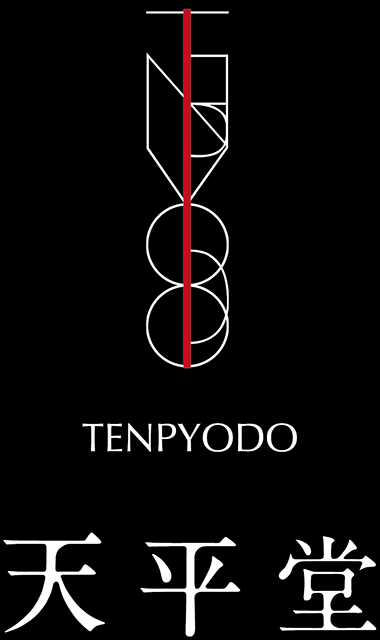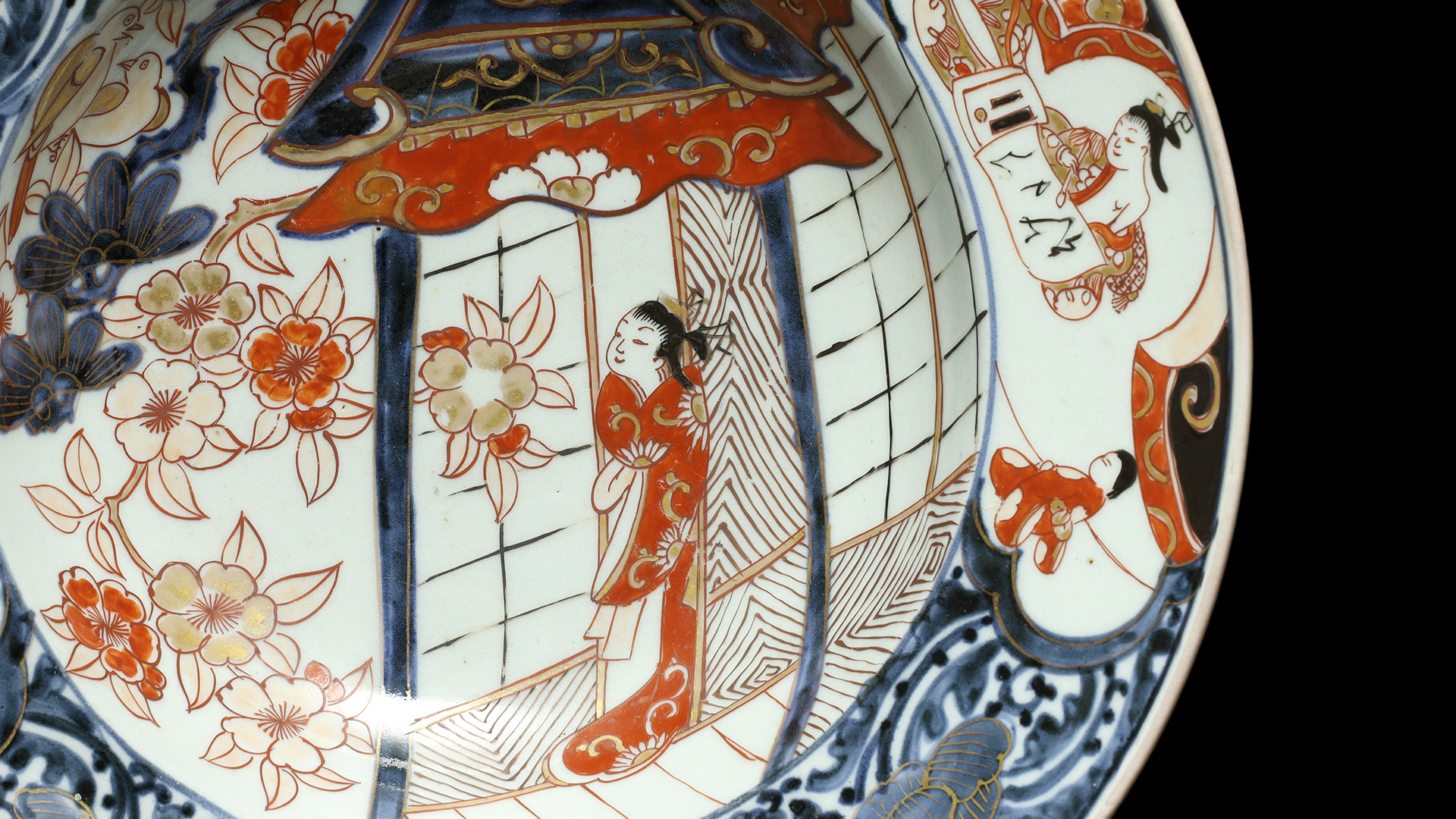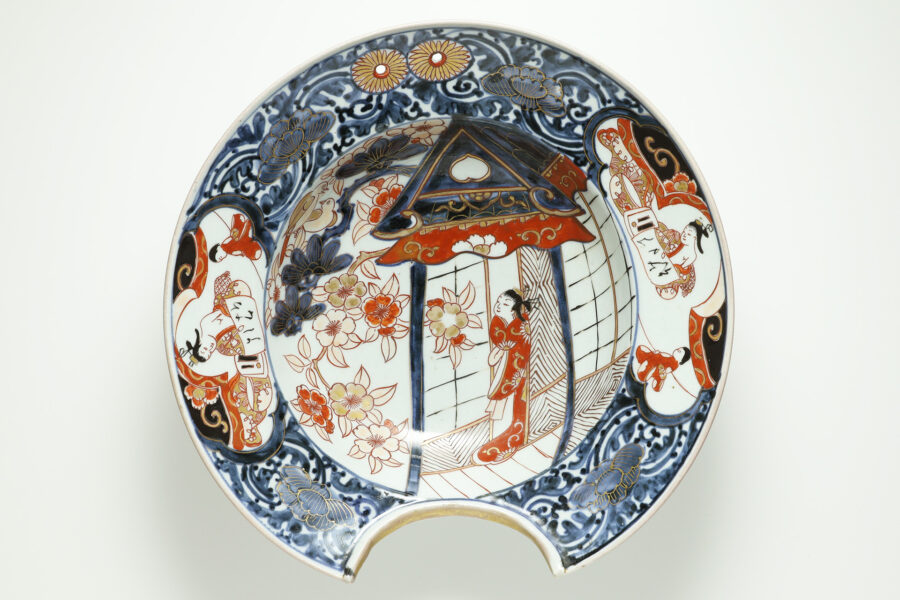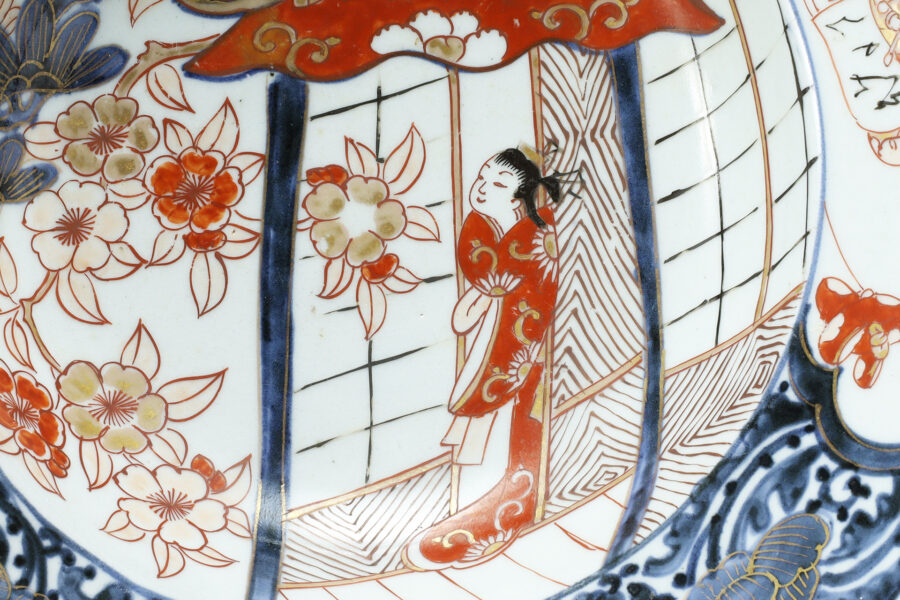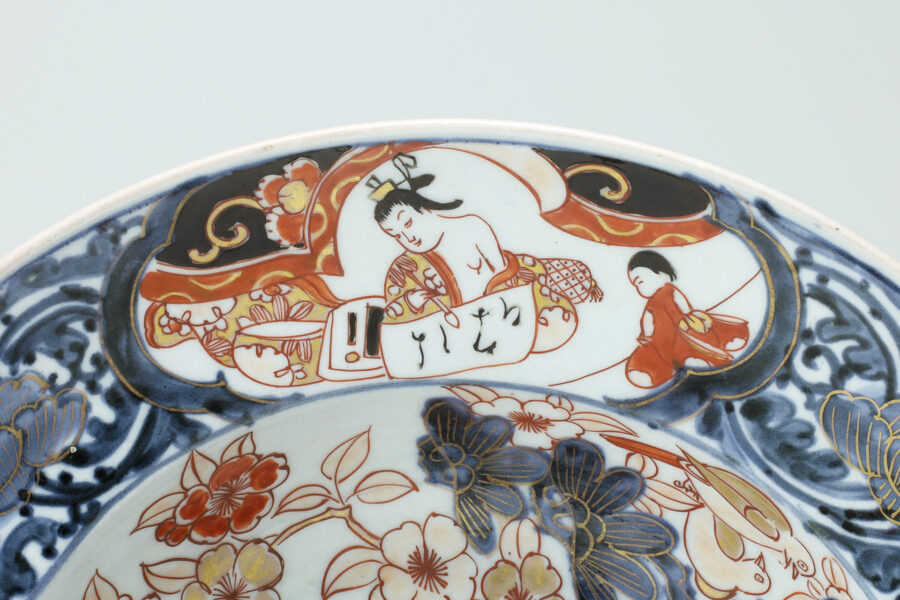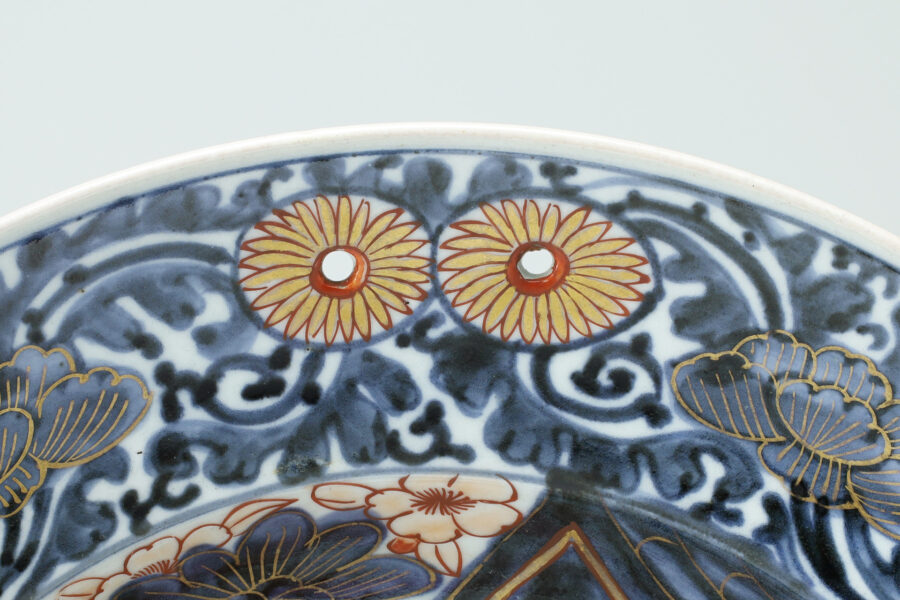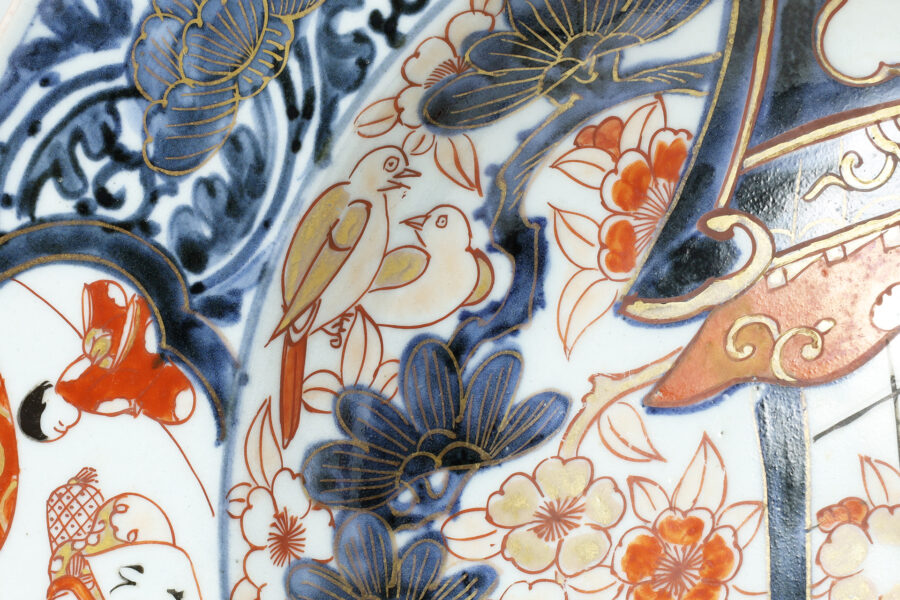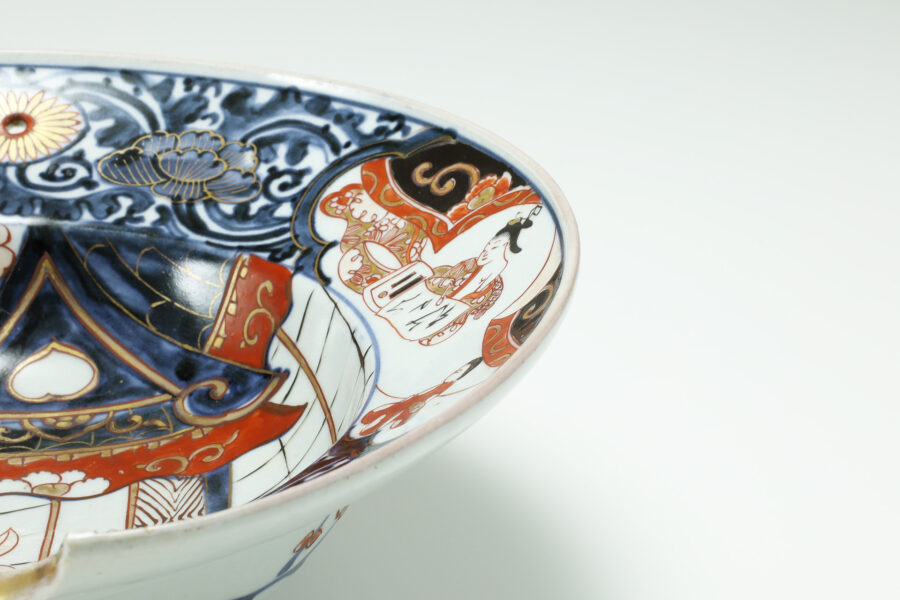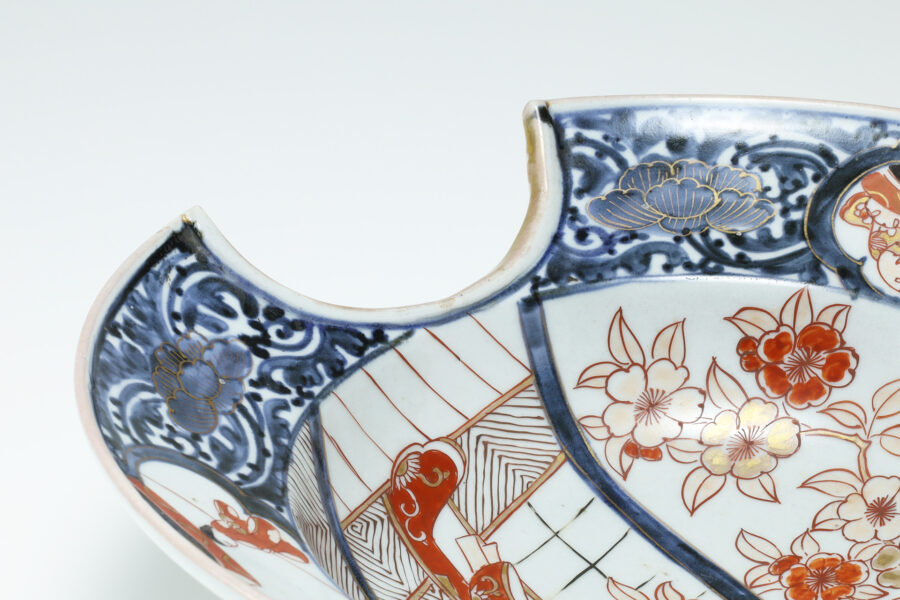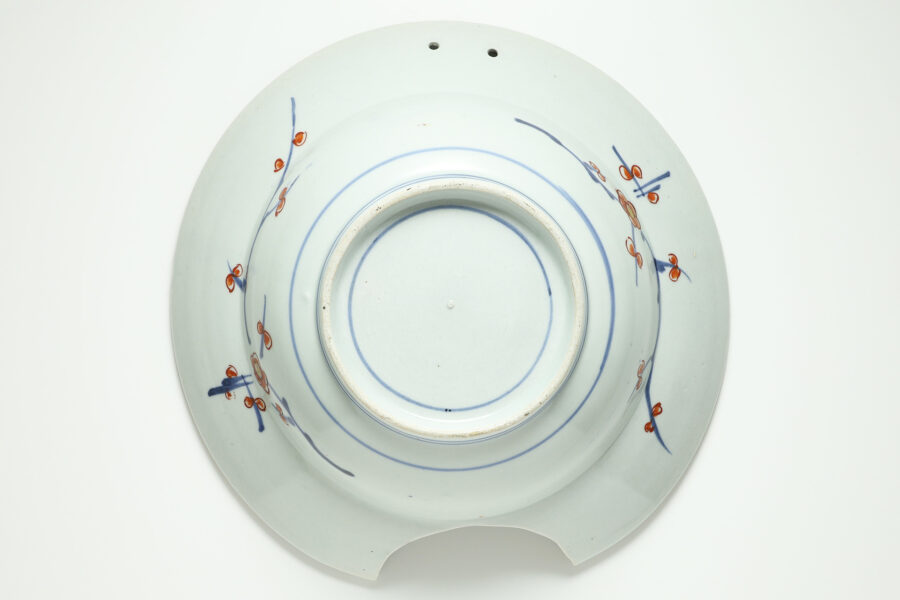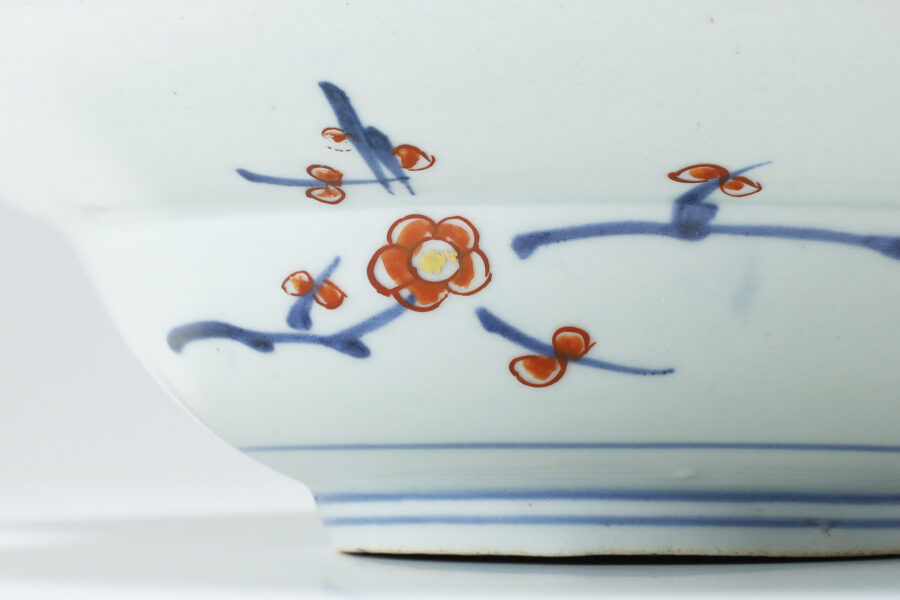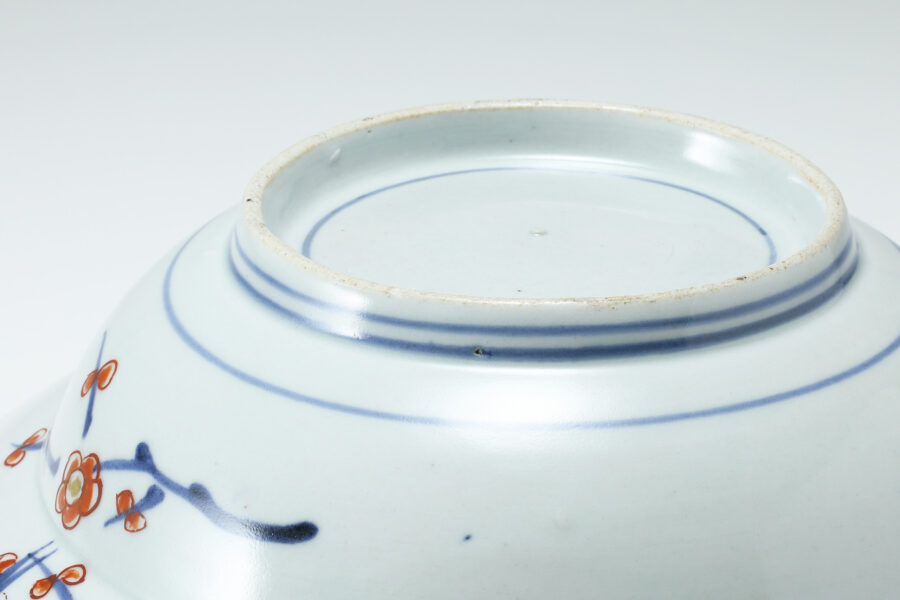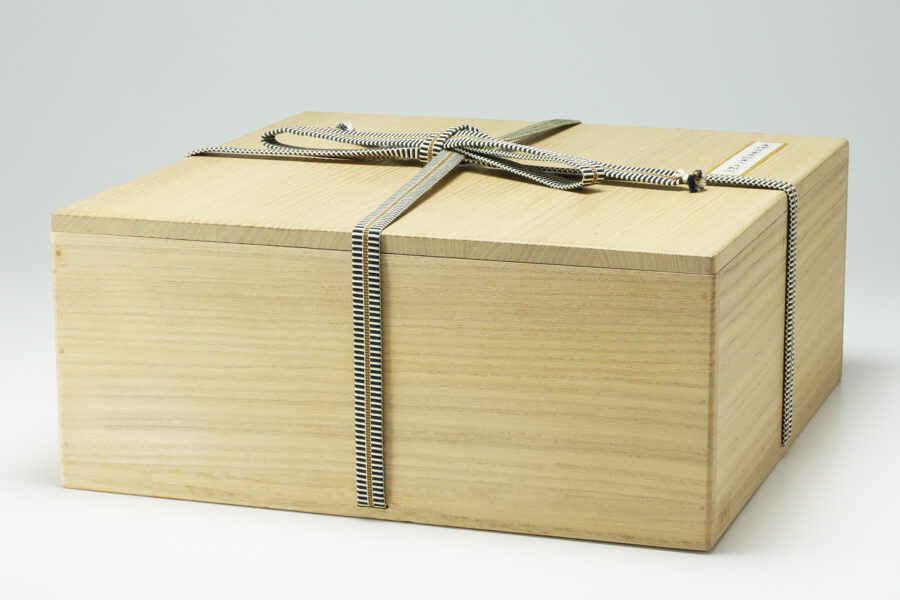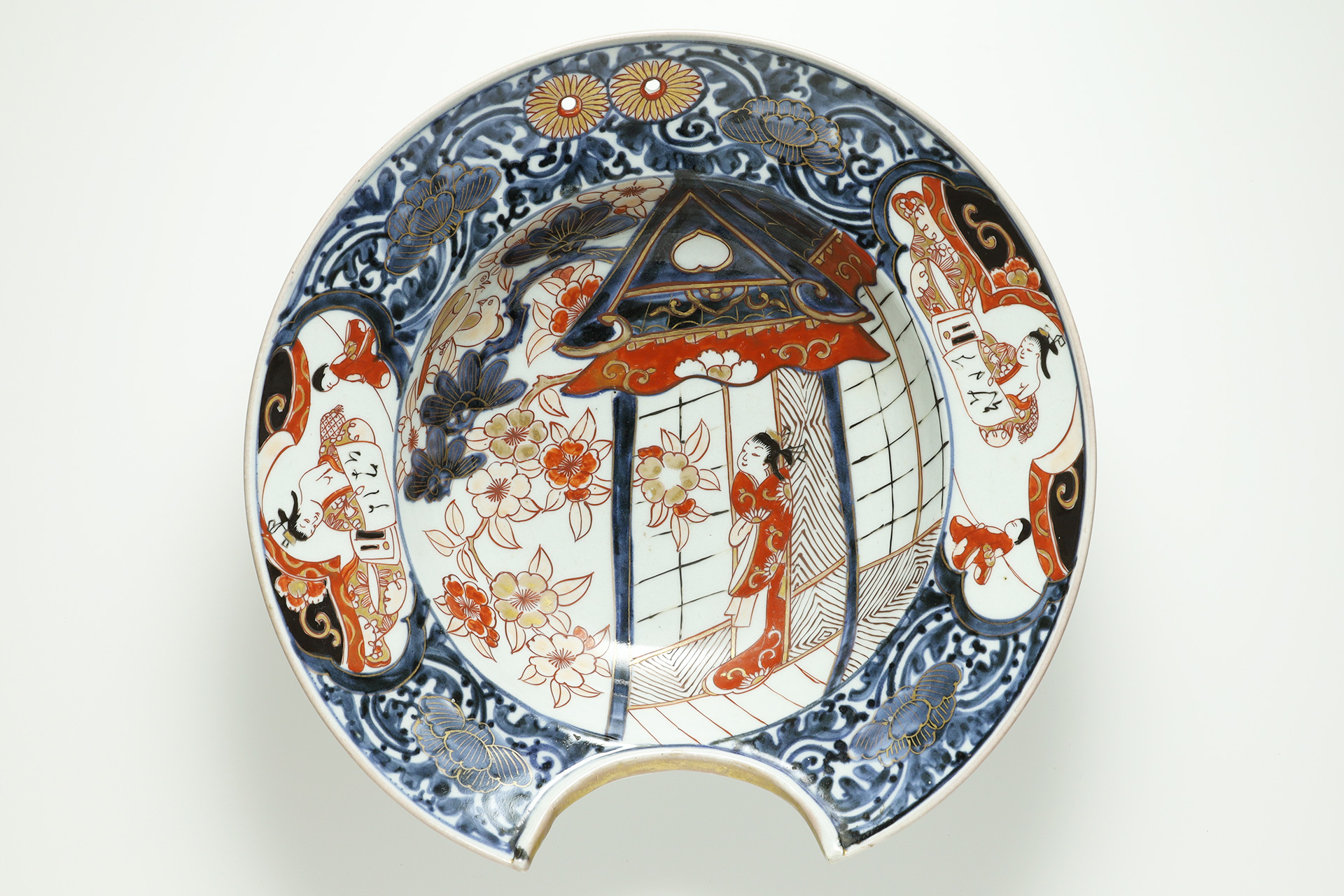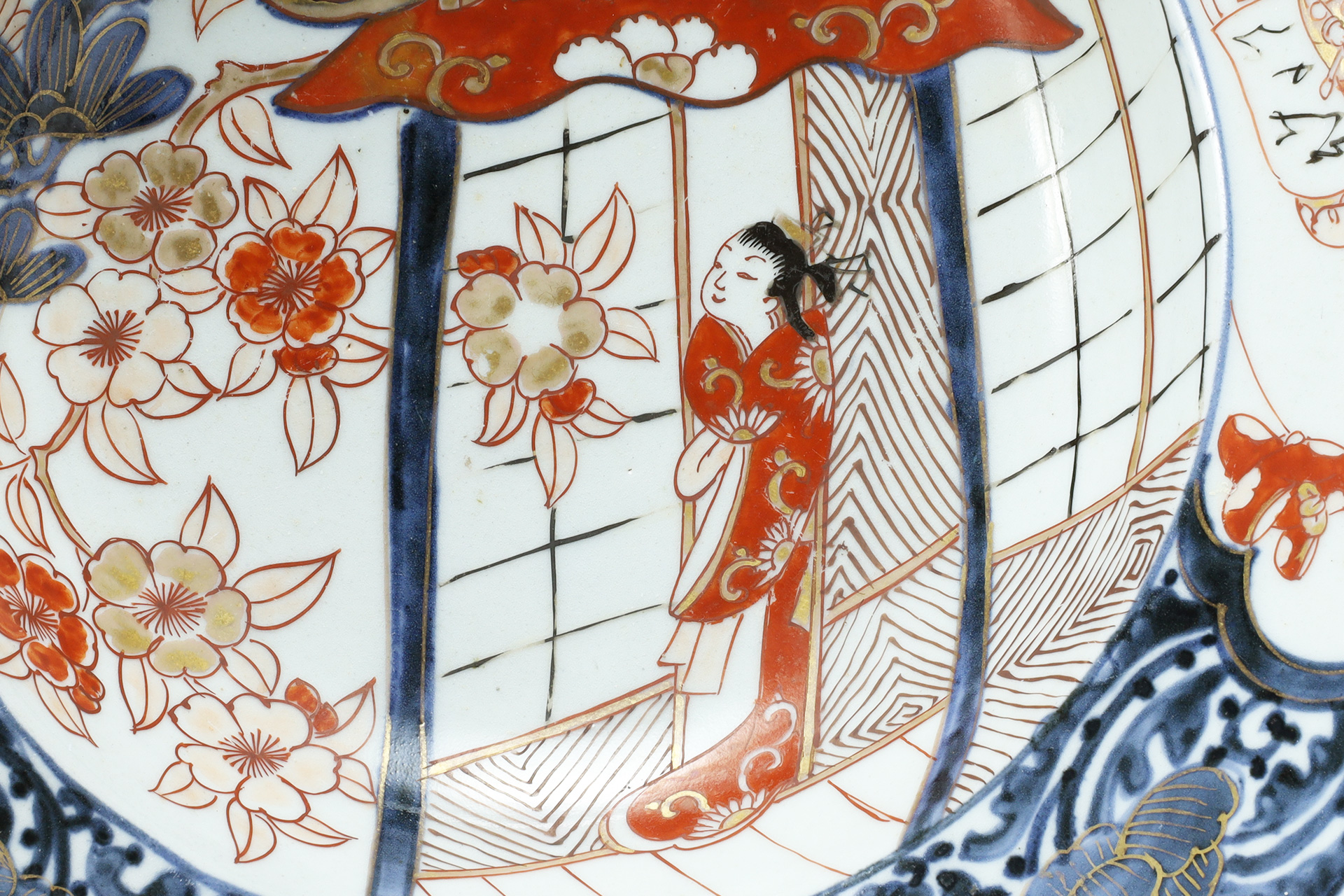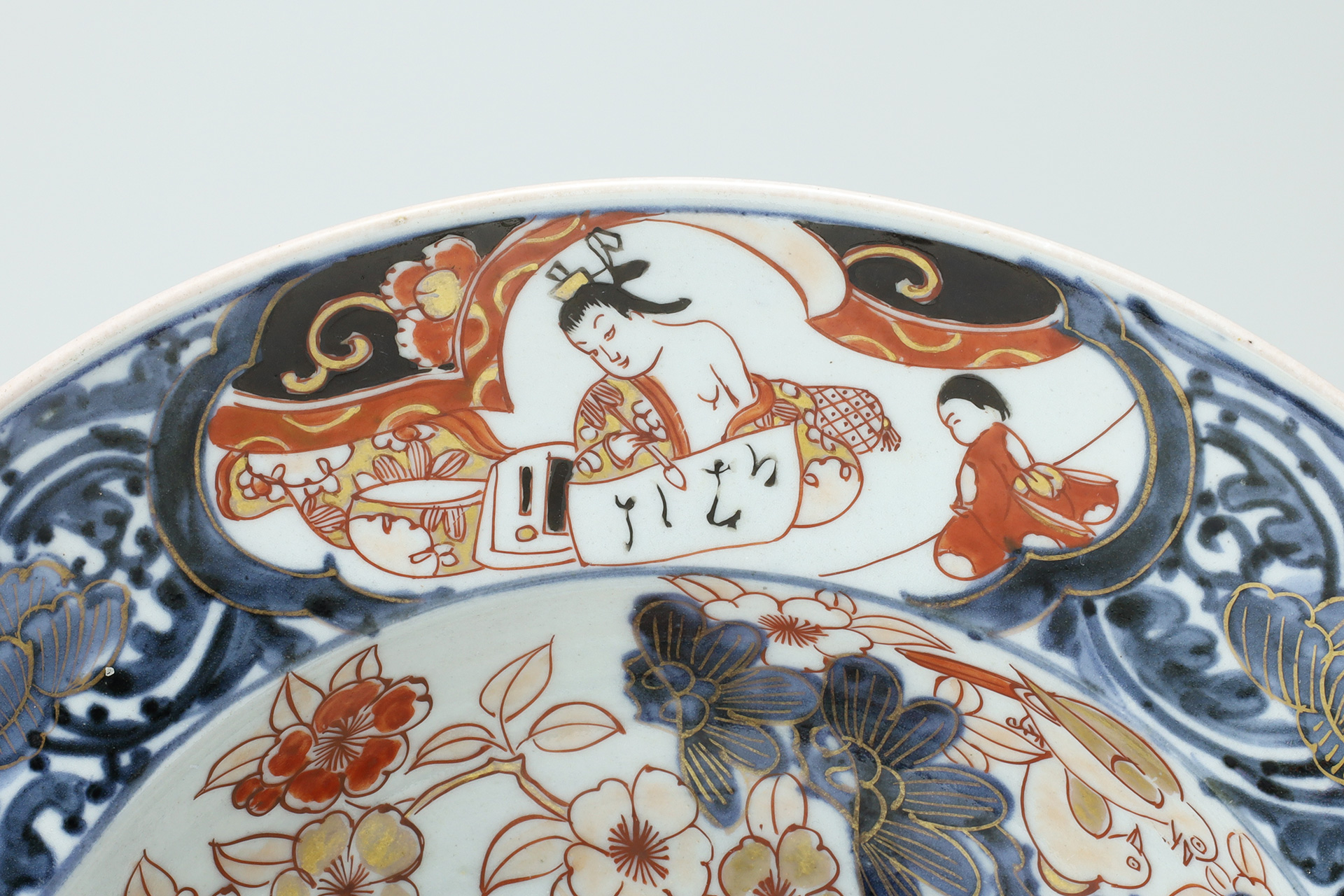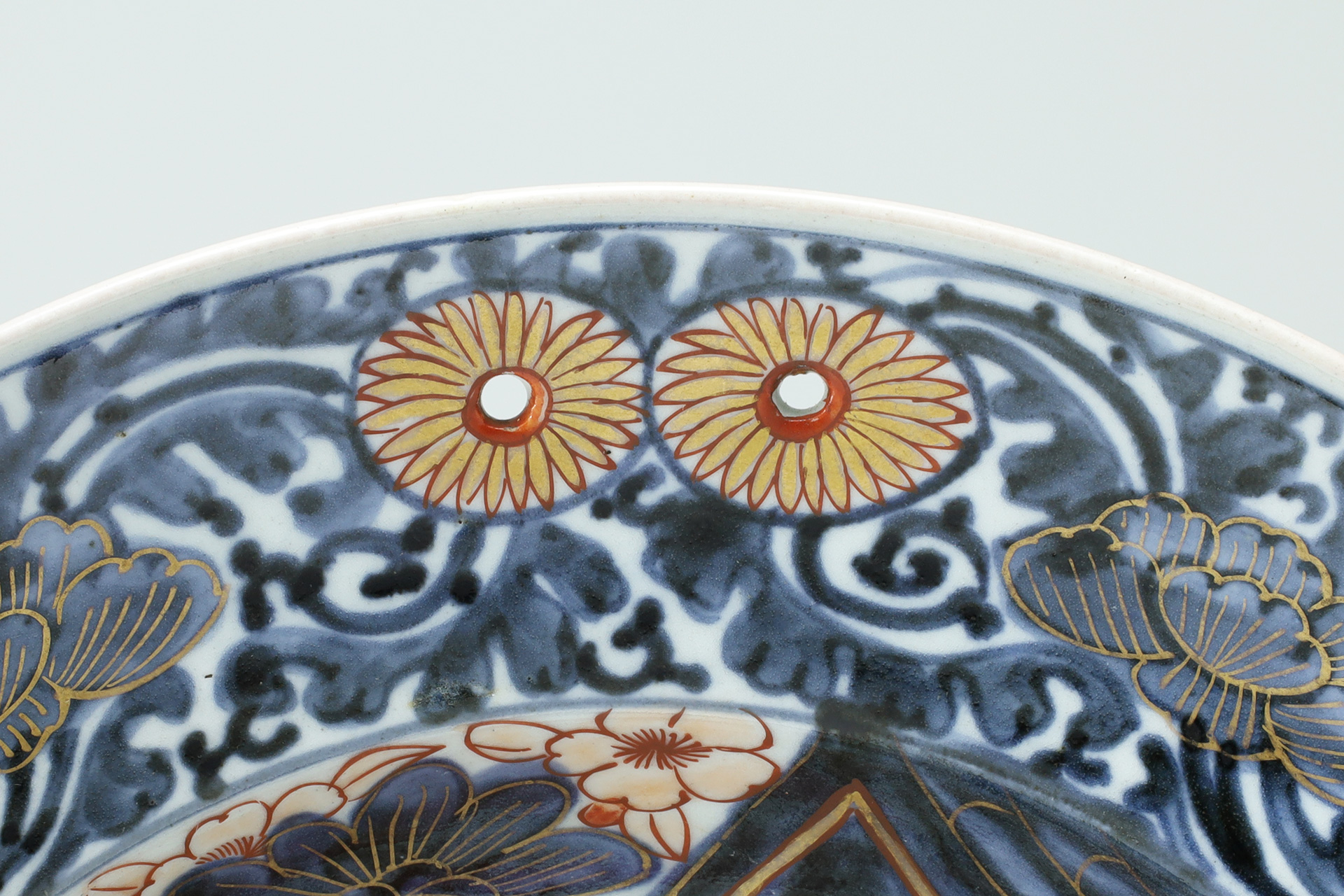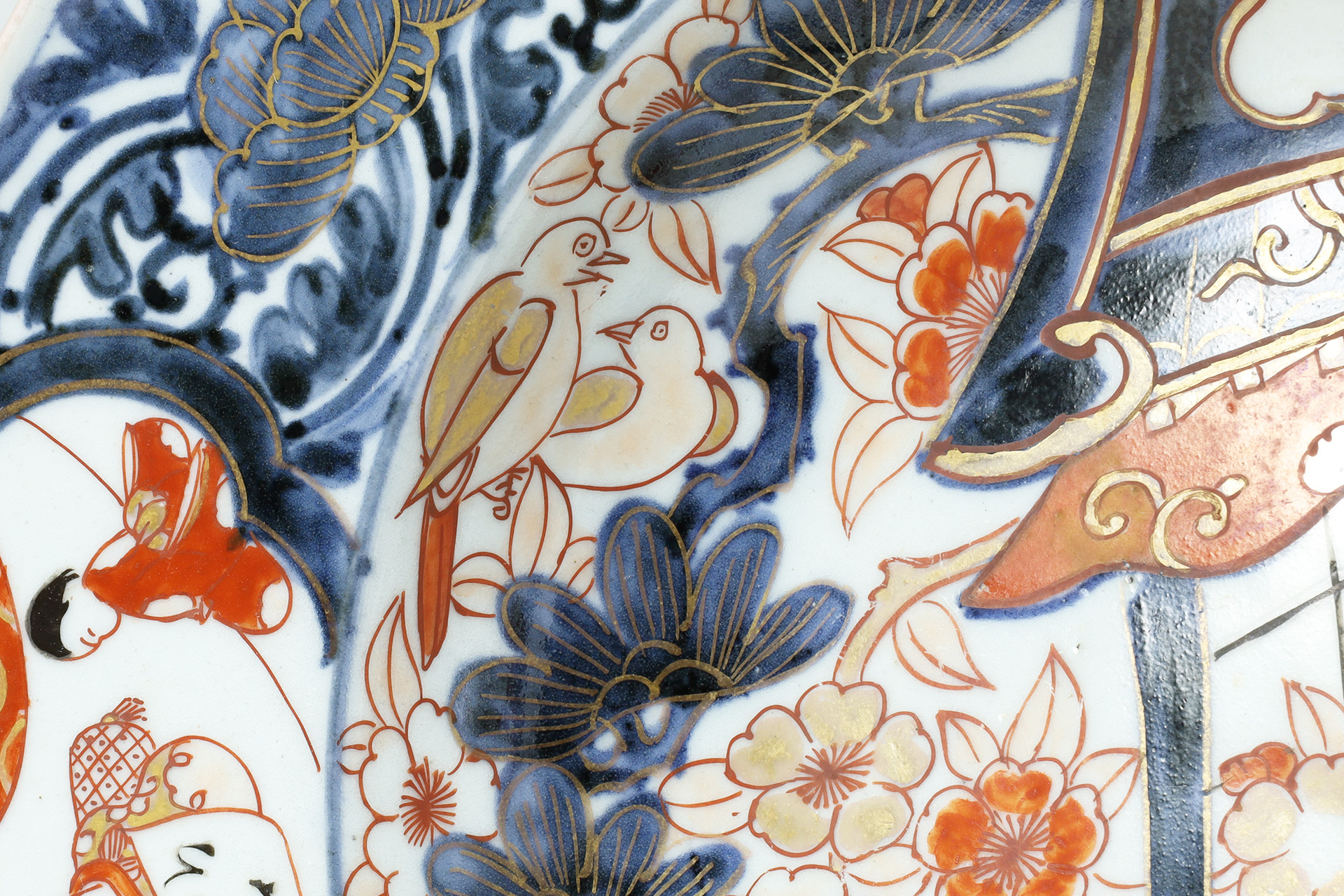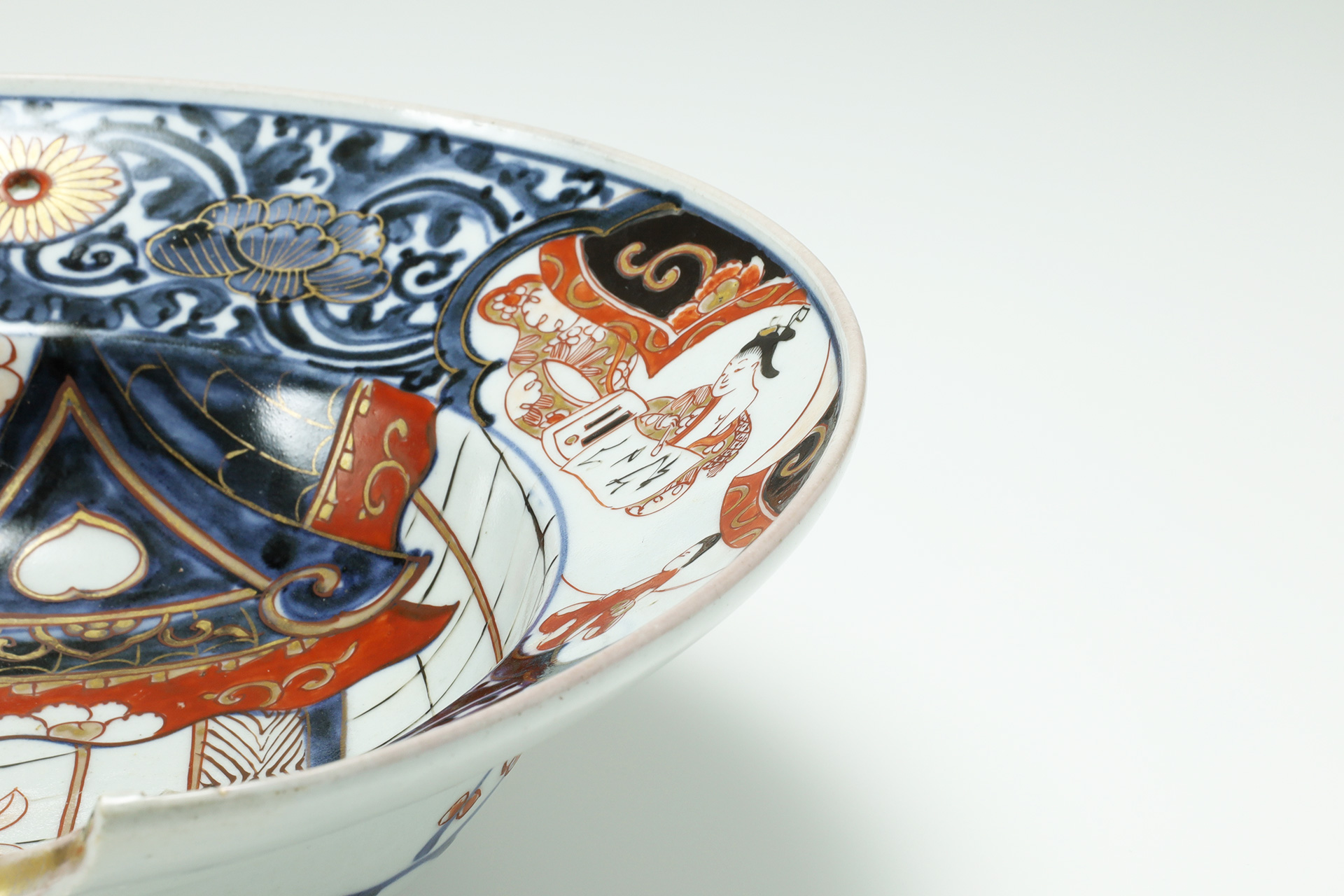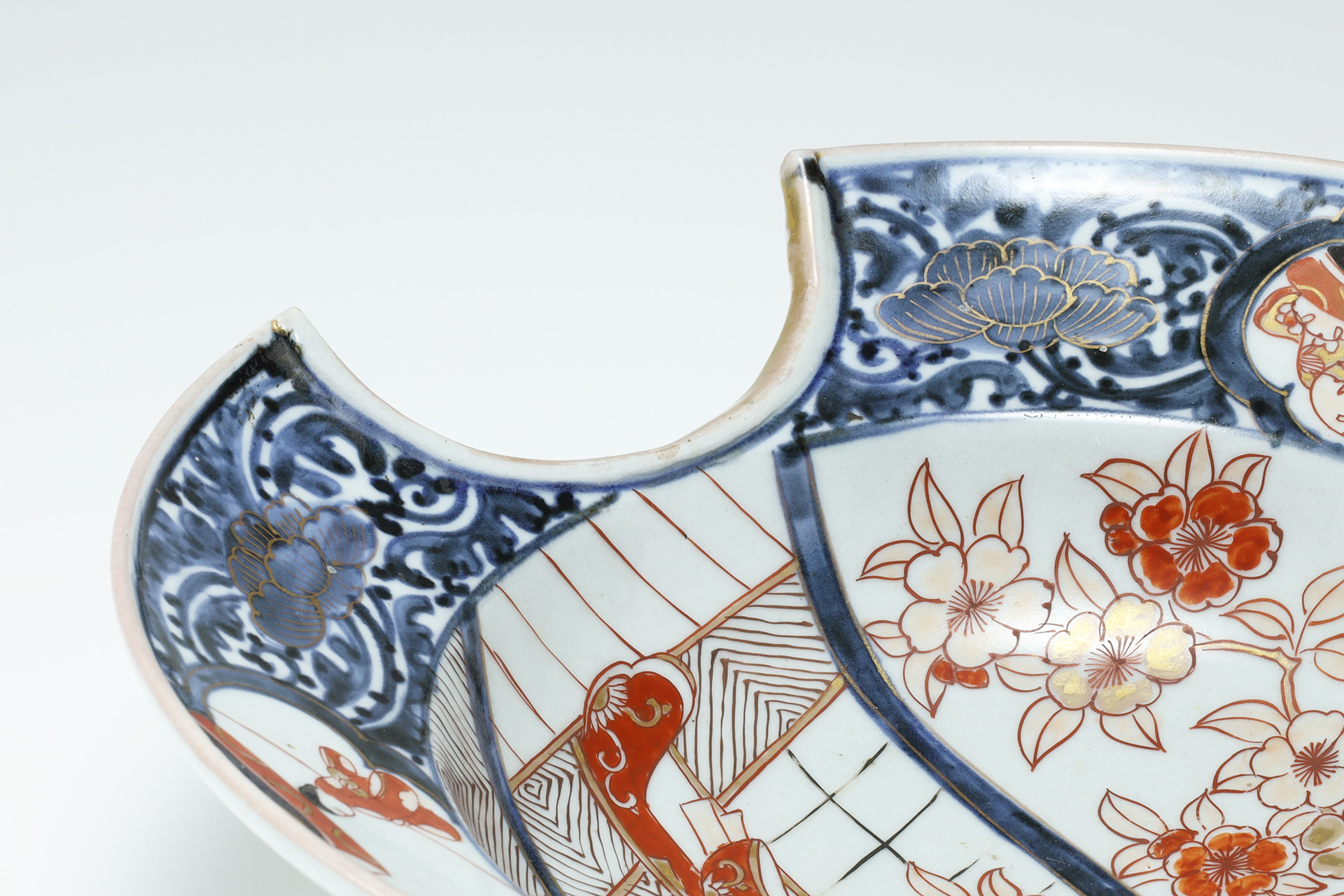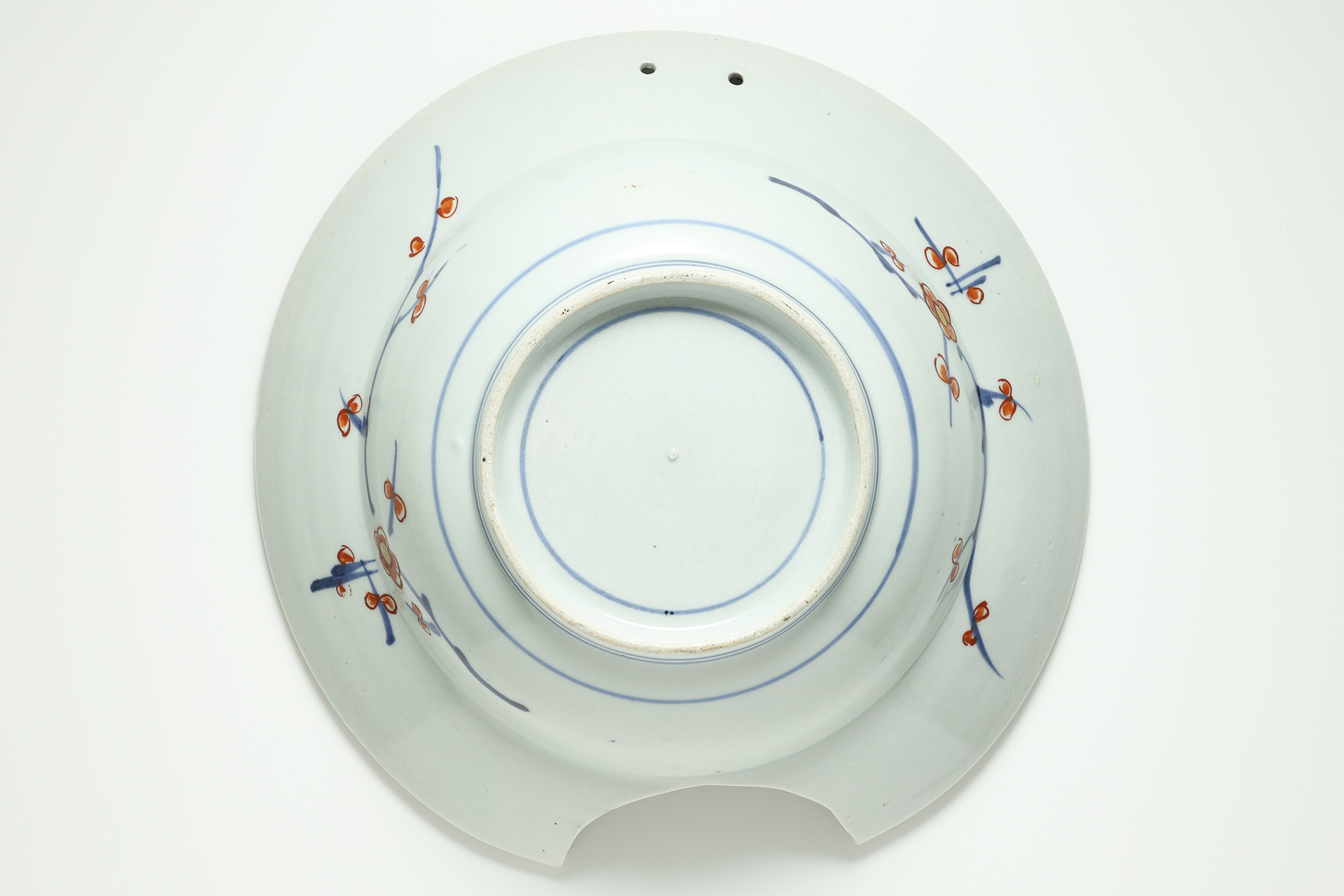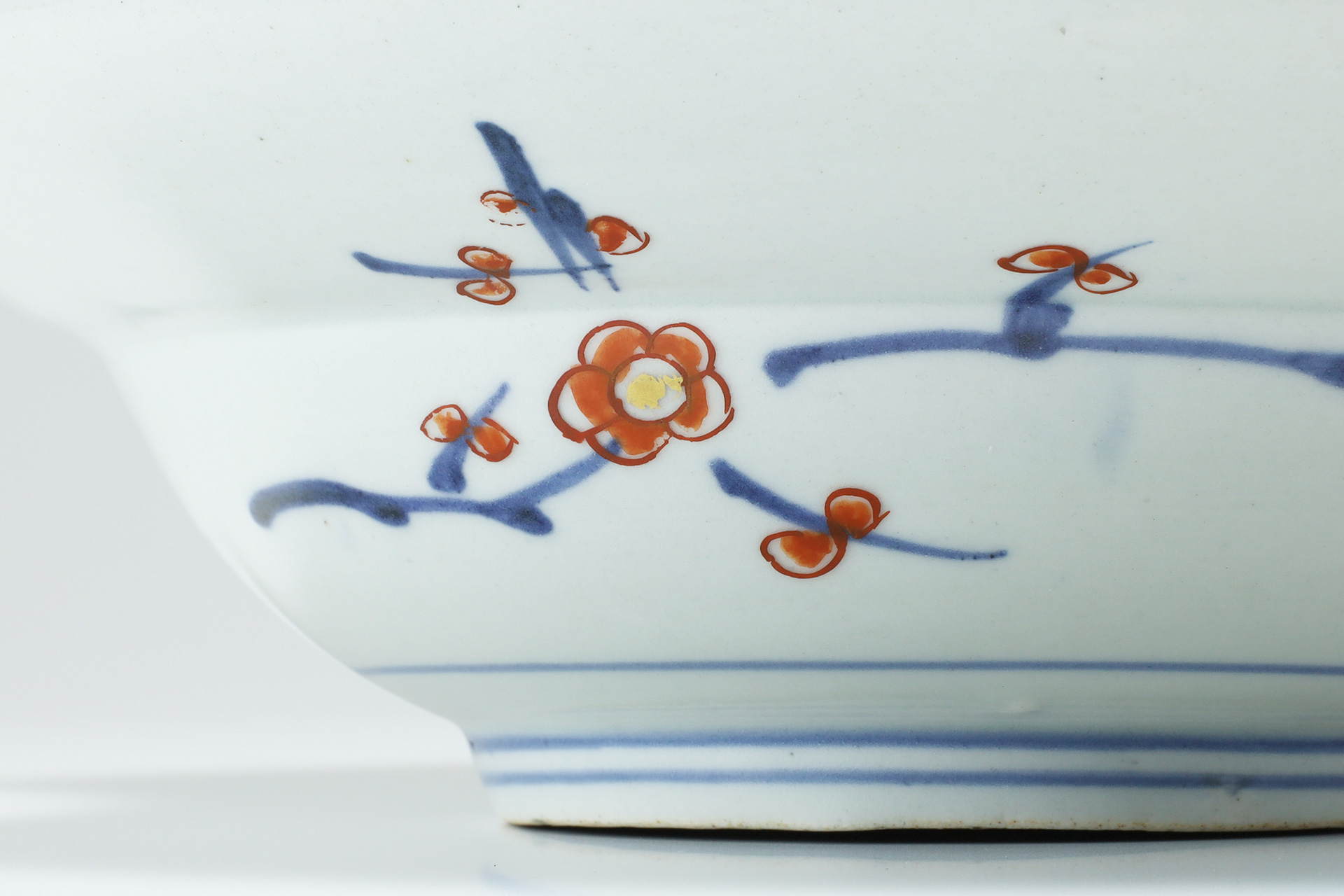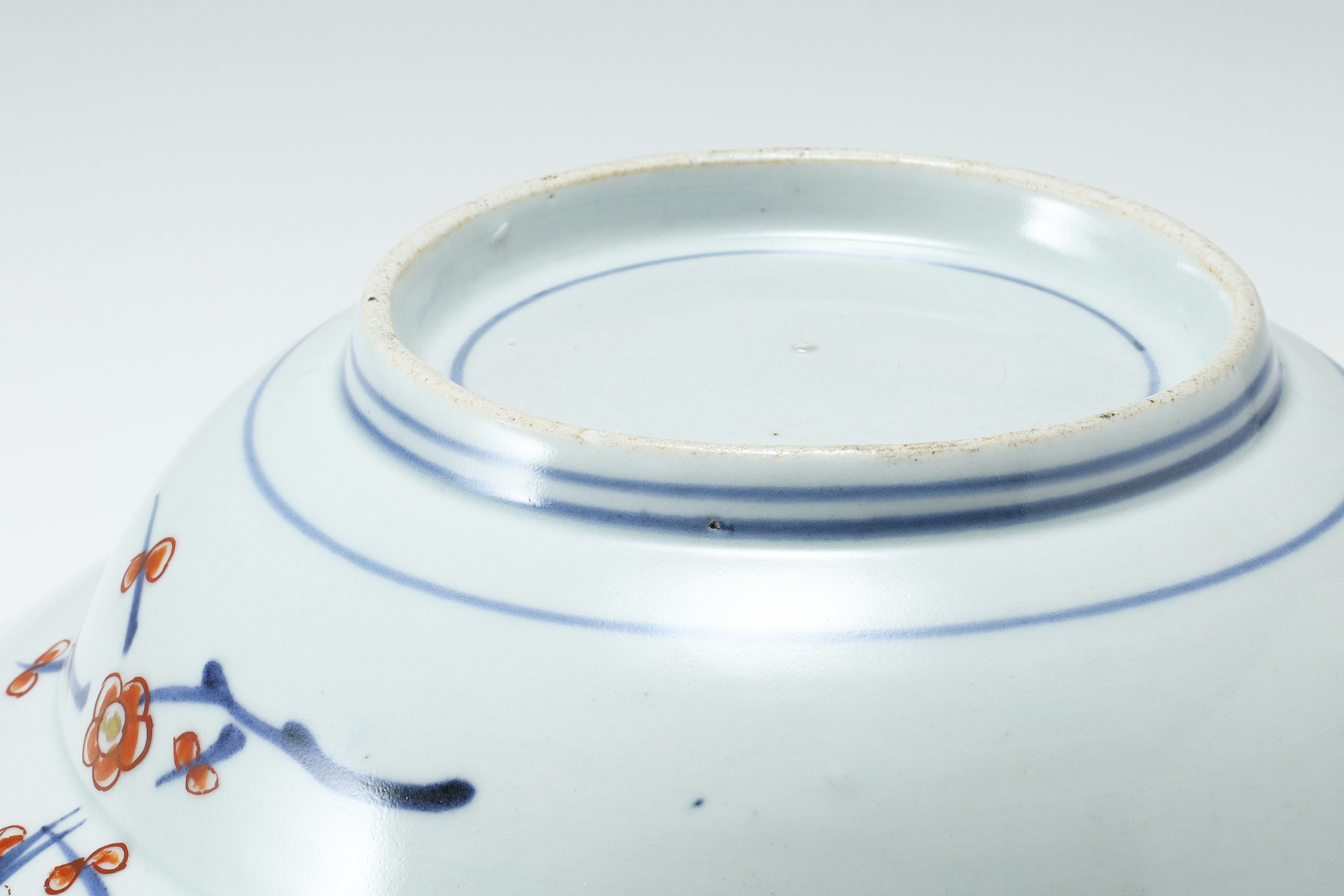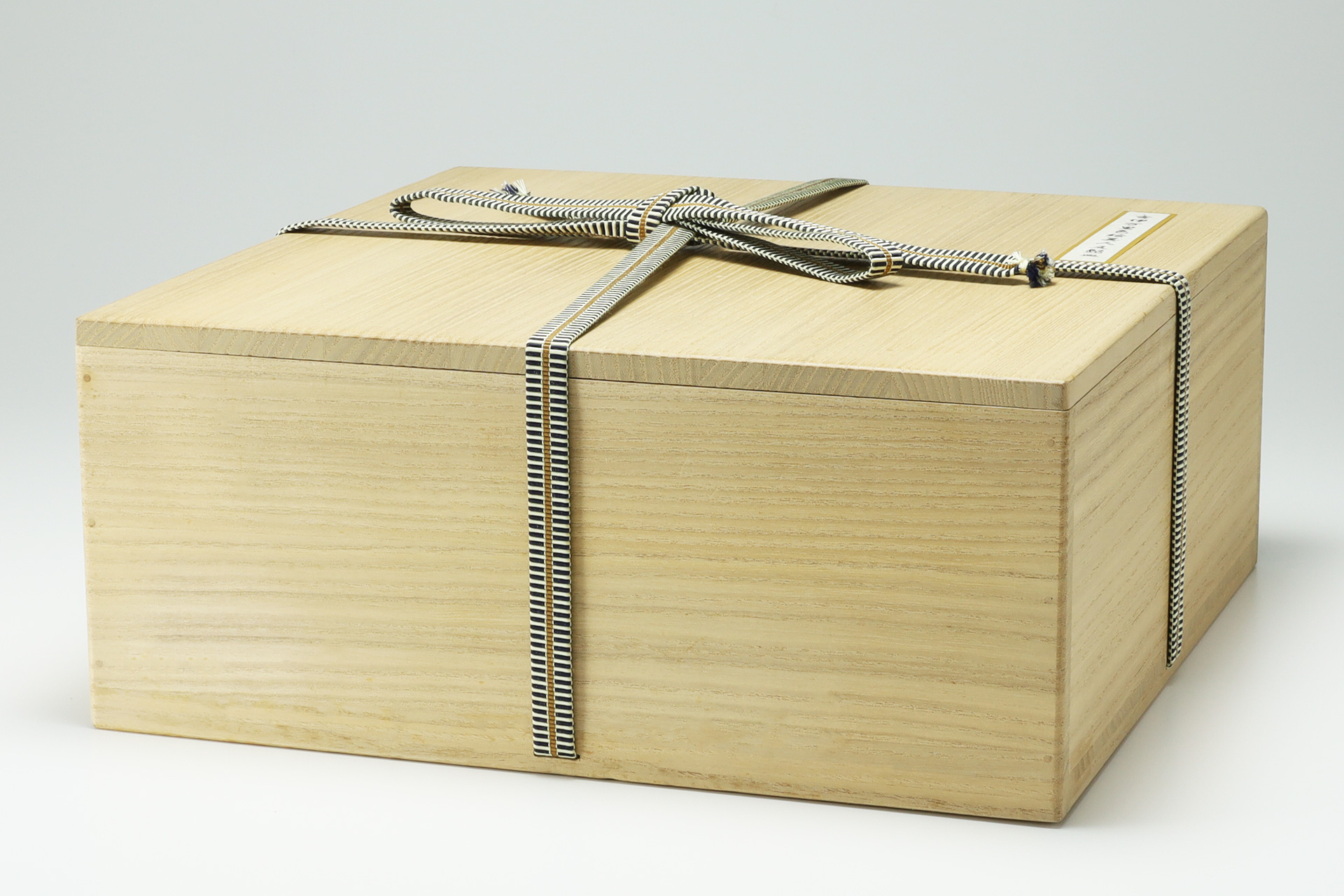The shaving basin is a representative piece of export old-imari made according to the order of VOC. It is a beautiful and emotional subject in which genroku beauty admire the cherry blossoms from their mansions, lured by two birds chirping to signal the arrival of spring.
Inquiry
- Product Code
- 230517-1
- Period
- Edo Period
Early 18th century
- Weight
- 1,026g
- Diameter
- 26.7cm
- Height
- 8.7cm
- Bottom Diameter
- 11.2cm
- Description
- Paulownia Box
- Condition
- Excellent Condition
It satisfies the requirements for the excellent work, with the beautiful glaze color and excellent baking. It is in good condition with no visible wear or scratches.
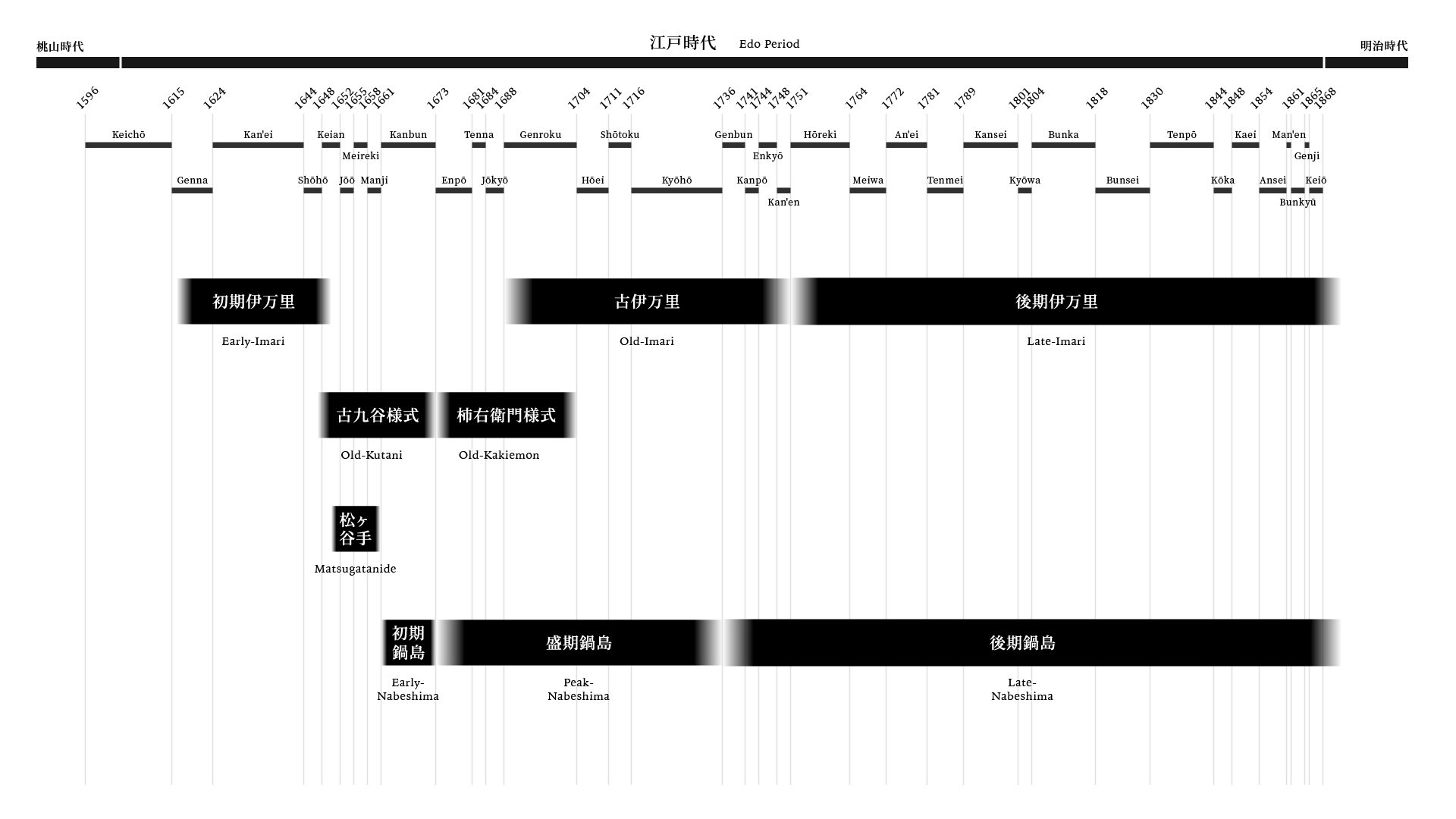
The dish with a distinctive shape in which part of the edge has been cut off in a semicircular shape is called a “Higezara(shaving basin)”. In europe, light metals such as brass were used, but it is speculated that porcelain was also made due to the interesting shape of the vessel. The overwhelming majority of designs in this category feature a basket of flowers in the center, and this one is based on the popular genroku beauty.
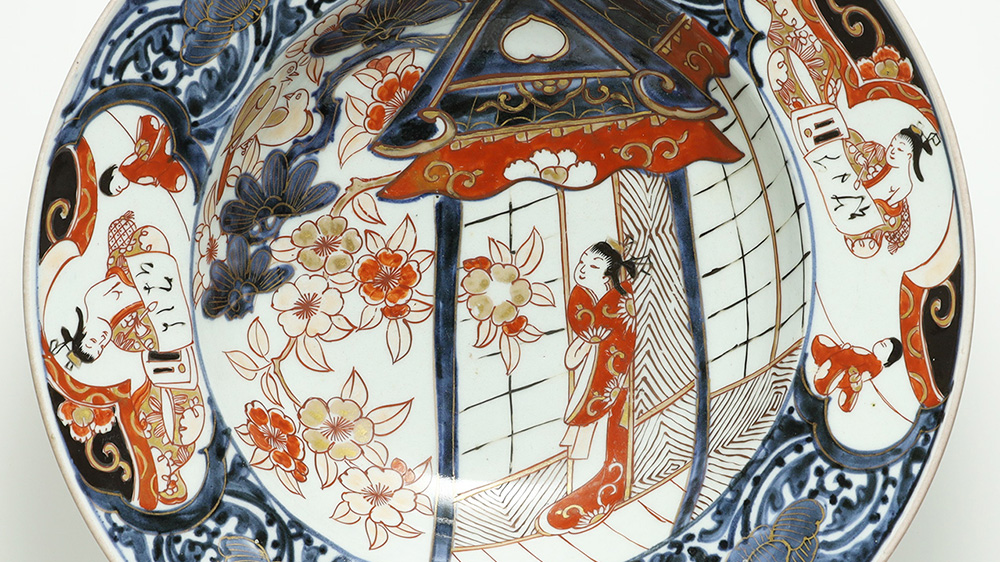
There was a hole in the top for a string to pass through, so it could be hung on a wall for decoration.
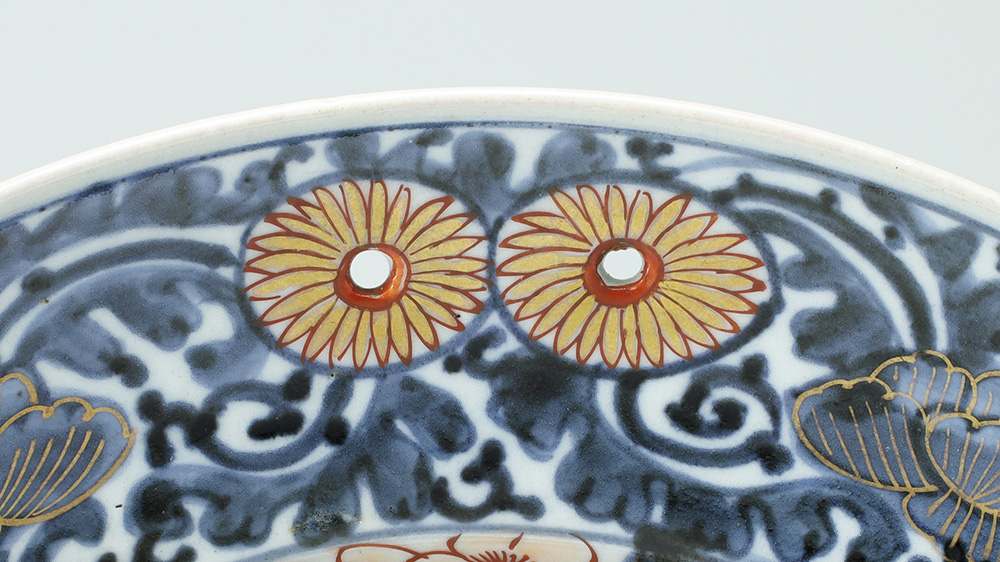
The beautiful woman’s black hair and handwriting are covered with purple paint over black paint. During the old-kutani and old-kakiemon, green paint was used to cover the top, but from the 1700s onwards, purple became the main color.
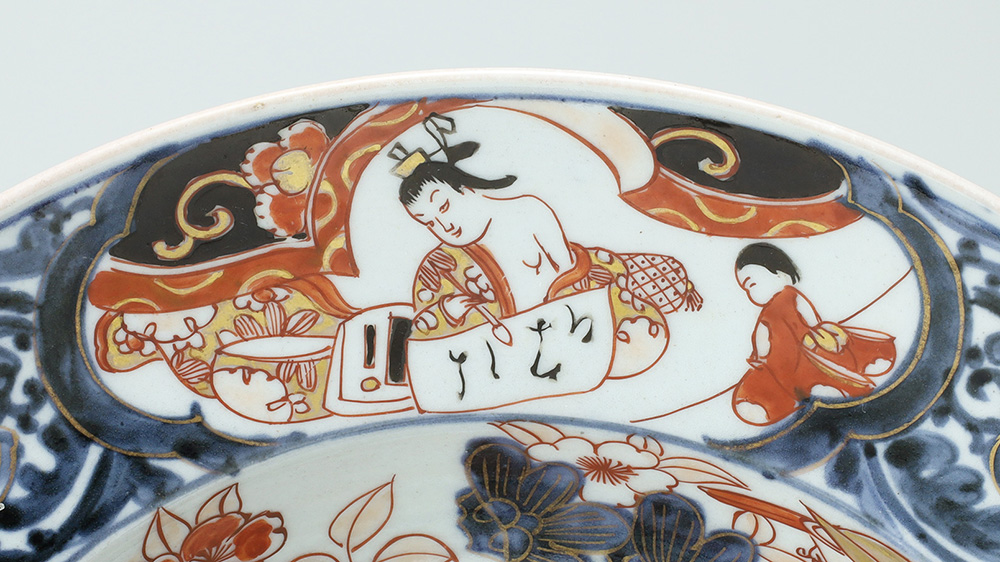
There is a theory that it was used not only for shaving but also as a receptacle for bloodletting therapy, but today it is most natural to think that it was used for interior decoration.
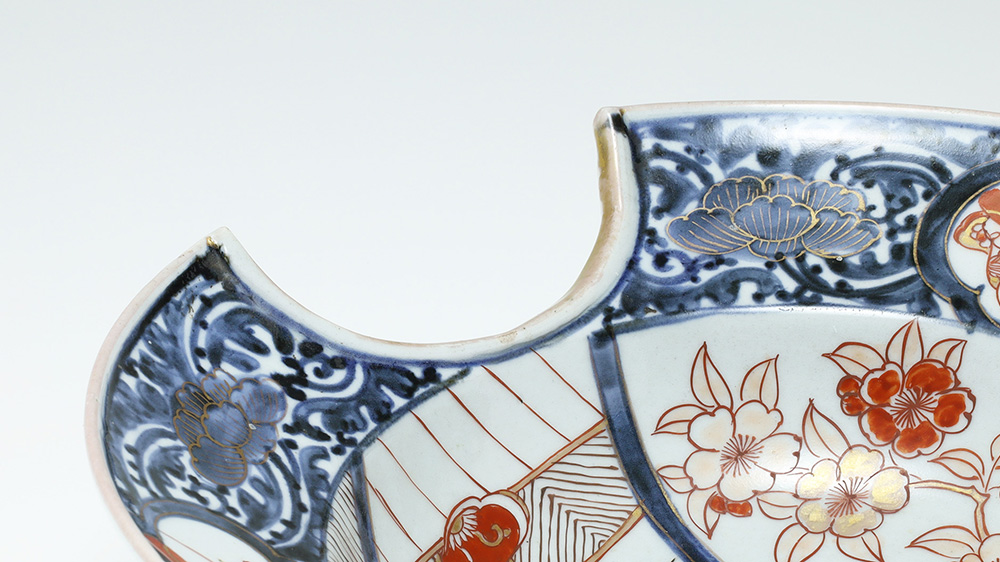
Old-Imari
https://tenpyodo.com/en/dictionaries/old-imari/
Old-imari refers to the porcelain produced in arita, hizen province, during the middle edo period. While it is known for domestic works such as katamono, its main focus was on a variety of export works that stimulated a taste for exoticism. As arita porcelain secured its place in the global market as the best alternative to jingdezhen porcelain, a division of labor system was established by skilled artisans to mass produce high quality works. Old-imari is characterized by the extensive use of overglaze enamels and gold on blue and white porcelain, exemplified by the dazzling “Kinrande”. Reflecting the cultural prosperity of the Genroku era(1688-1704), it created a world of elegance and splendor. Originally, this decorative technique was perfected at the jingdezhen kiln during the Jiajing era(1522-66)of the ming dynasty, and is filled with the luxurious taste of fired gold foil. In europe, the porcelain room, where the interiors of palaces were decorated with porcelain, became popular among royalty and nobility as a symbol of wealth and power. Here, porcelain served not only as art objects displayed on shelves and walls but also as furnishings for entertaining guests. Consequently, many works can be found with worn out colors and gold due to age related deterioration. The terms “Old-Imari”, “Old-Japan” and “Imari-Ware” are still used today as affectionate names for hizen porcelain by pottery enthusiasts and collectors both in japan and abroad.
Shaving Basin
The higezara(shaving basin)was a dish used for shaving and washing one’s beard, with part of the wide mouth rim cut off in a semi circle shape. Shaving basin were also popular as decorative wall dishes, with strings threaded through the two small holes in the top. It was highly popular as typical exported old-imari ware because of its unique vessel shape and diverse designs.
The Era Establishing the Export Industry Between the VOC and Japan
The east india companies were chartered companies established by european countries in the 17th century(the british in 1600, the dutch in 1602, and the french in 1604)for trade with the orient. The dutch east india company’s monogram, consisting of the initials “VOC”(Verenigde Oostindische Compagnie), was its emblem, was put on warehouses, coins, cannons, flags, ceramics, etc, to indicate the company’s ownership of products. In addition to spices, its original product of interest, the company also sought porcelain that could not be produced in europe and traded with china. The hard porcelain imported from china was called “White Gold” and was traded as a valuable item, rivaling gold in value. Once vast quantities of porcelain, a luxury item and symbol of wealth, were brought to europe, its beauty deeply impressed europeans, encouraging china to produce even more products. However, due to the civil war following the change between the ming and qing dynasties in the 1640s and policies restricting overseas trade, the quality of porcelain fired in the jingdezhen kiln and other porcelain kilns became inferior, making it almost impossible to buy porcelain products. As a result, the company sought japanese porcelain, which could be produced without interruption, as an alternative. In 1653, japan entered into an export deal with the dutch east india company(VOC)for imari ware. In 1659, japan received a massive order of about 56,700 pieces, ushering in a glamorous era for the export industry in japan. The new feudal system of the tokugawa government beginning to take shape, imari ware was thrust into the limelight of the international market as a product of the nabeshima clan of the saga domain. Because europe demanded identical replacements for chinese porcelain, many early pieces exported imitated the fuyode style and other styles from the late ming dynasty. The large volume of orders from the VOC led to significant technical advances at the hizen arita kilns, and the expanded capacity of these kilns made it possible to produce many jinko tsubo(agarwood jar). The exported porcelains varied widely in shape. Even considering this, it is clear that the expansion of trade with the VOC contributed to the significant flourishing of imari ware. When the qing dynasty lifted the qian-jie-ling(order blocking maritime traffic and trade)in 1684, exports of chinese porcelain resumed, and from around 1712, exports boomed. Chinese porcelain once again regained its dominant position in the market. As a result, imari ware lost out in market competition with chinese porcelain, which boasted quality, quantity, and low prices. China overwhelmingly outnumbered japan in the total number of porcelain exported through trade with the VOC. The establishment of meissen, the first porcelain kiln in europe, in 1710 contributed to the gradual decline of porcelain exports from asia. The official japanese porcelain trade ended in 1757 with a mere 300 pieces and then was left to private trade by the trading houses.
Events Related to the VOC
- 1602:Establishment of the dutch east india company(VOC).
- 1609:Establishment of the dutch trading post in hirado.
- 1641:Relocation of the dutch trading post to dejima, nagasaki.
- 1644:End of porcelain exports from china to the VOC, following a decline in porcelain exports beginning in about 1640.
- 1650:Beginning of export of porcelain from japan as a replacement for chinese porcelain.
- 1651:Beginning of exports to chinese merchants in addition to dutch merchants, where imari ware was acquired by the dutch and chinese alike.
- 1653:Signing of export agreement with VOC for imari ware, beginning their export. Records remain of these trades.
- 1659:Beginning of full scale export of blue and white porcelains, including fuyoude, etc., after receiving a large order(approx. 56,700 pieces)of imari ware from the VOC.
- 1661:Prohibition of chinese porcelain exports in the qing dynasty following the qian-jie-ling proclamation.
- 1684:Resumption of exports of chinese porcelain after the lifting of the qian-jie-ling proclamation.
- 1710:Establishment of a porcelain factory in meissen, germany.
- The shotoku era(1711-16):Tightening of restrictions on foreign trade, leading to a halving of the number of dutch and chinese ships arriving at dejima. Thus, porcelain exports also began to decline.
- 1725:Stagnation of trade between japan and the VOC.
- 1757:End of official porcelain trade after only 300 pieces according to the VOC records, thereafter relegated to private trade by the trading houses.
- 1799:Dissolution of the VOC.
